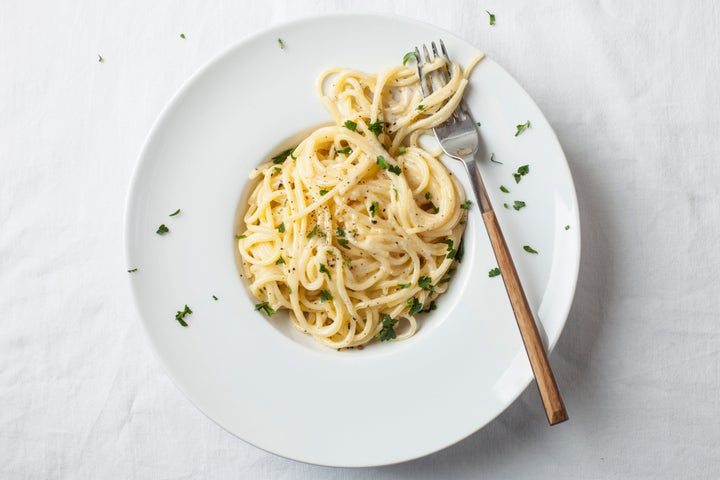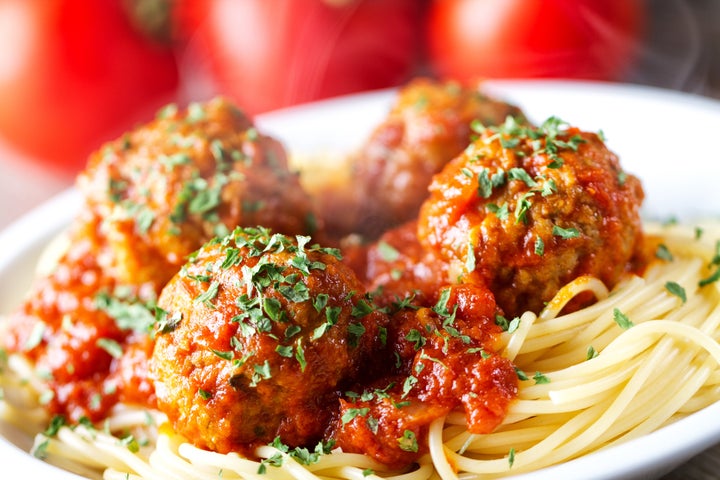
If you’ve ever headed to a restaurant in the Little Italy section of an American city and sat down at a checkered tablecloth, there’s a good chance the dish you ordered wasn’t Italian at all. Instead, it likely fell into a culinary category known as “Italian American.” Beloved dishes like chicken Parmesan, baked ziti, and basically the entire Olive Garden menu all qualify as Italian American. This cuisine focuses on dishes invented by Italian immigrants using ingredients readily available in the United States.
“When Italians began to immigrate to the US, most hailed from poor, rural backgrounds and their cooking was leaner with few ingredients, dishes were mostly vegetarian, and they basically used whatever was available to them,” explained Gennaro Contaldo, a celebrated London-based chef and cookbook author best known for mentoring Jamie Oliver during his Italian cooking education. He explained that when Italian immigrants made it to the United States “and saw the abundance of ingredients available to them, the dishes they had learned to cook back home began to stray from the ‘cucina povera’ into a richer, often meatier cuisine.”
Let’s be clear: Many people love Italian American cuisine and believe this type of dining created by Italians in the US is completely authentic to its own history, its own creators, and its own culture. Giuseppe Gentile, executive chef of L’Antica Pizzeria da Michele in Naples, Italy, and its four US locations in California and New York, also understands the appeal of Italian American cuisine, acknowledging that these dishes “seem to be more comforting in some ways” than many dishes created in Italy proper.
That said, if you want to dine the way Italians do in their home country, it’s important to understand that Italian cuisine follows very different rules than its Italian American counterpart. “The principle of Italian food is freshness. We like to keep recipes simple and want the customer to taste the ingredients, not have them camouflaged by heavy butter and cream,” explains Pietro Gallo, executive chef and co-owner of Civico 1845 in San Diego.
Giuseppe Gaeta, executive chef of Cipriani Las Vegas, also points out the importance of fresh and local ingredients to Italian food. “We grew up eating what the field would provide that season in addition to what you farmed, hunted and fished,” Gaeta said. “By utilising fresh ingredients, the flavours are more intense. Everything has a purpose.”
By contrast, Italian American food “often amps up the garlic, sauce and cheese, plus the portions are much bigger!” said Fabio Pizzigoni, executive chef of Ambrogio15 in Phoenix. Fabio Viviani, a Top Chef alum and prolific restaurateur, noted that “many Americans still expect a plate of pasta to be smothered in sauce, whereas in Italy, the pasta itself is the star, and the sauce is just there to enhance the flavour of the pasta.”
When visiting Italian restaurants in the United States, these Italian chefs agree that certain menu items either can’t fulfil their Italian origins or don’t exist in Italy at all (and therefore don’t play a role in authentic Italian cuisine). These seven dishes serve as prime examples.
Fettuccine Alfredo
When we surveyed this group of Italian chefs for the Italian American dish that most violates their Italian ideas of “good food,” they overwhelmingly agreed on the consistently popular fettuccine Alfredo.
“For an Italian, fettuccine Alfredo is a big no in the rule book!” said Jacopo Falleni, owner of Nonna in Westlake Village, California. “In Italy, pasta dishes are all about keeping it simple and letting each ingredient shine. But Alfredo is loaded with cream and butter, which is way too heavy. It really misses the mark on what Italian pasta is all about, which is simplicity and elegance. And then there’s the chicken — total disaster! It’s like putting ketchup on risotto. Just ... why? I wish I could use a hand gesture to show how wrong it is!”
Marinara Sauce
While marinara sauce is an item you can find in Italy, our chefs warn that the Italian version of marinara bears little resemblance to the American spin.
“I consider myself to be an open-minded chef, but when I go out, I cannot stand to order American marinara sauce or even make it at home, as there is usually a unique sweetness with flavours of fake oregano and garlic peppered in,” Gentile admitted. “Unlike American marinara sauce, normally a good tomato sauce [in Italy] is a bit sour.”
Pizzas With Unconventional Toppings
These Italian chefs generally acknowledge that America has something to contribute to the pizza conversation (much to the relief of pizza snobs in New York, Chicago, New Haven and other pizza hot spots). But when it comes to “creative” toppings, the chefs find themselves no longer on board with the United States’ pizza innovations. “American pizzas have become too much, and some are too ‘out there,’ so I recommend sticking with simple ingredients,” Gaeta said.
A specific American pizza topping that Italian chefs don’t appreciate is pineapple. “Pineapple doesn’t go on pizza. It’s a fruit that doesn’t match with Italian flavours. It’s too strong and the finish will cover most of the delicate flavours of the other ingredients,” said Matteo Venini, executive chef and co-owner of Stellina Pizzeria in Washington, D.C. He’s not entirely against fruit on pizza; Venini says that “at Stellina, we serve pizzas with figs or pears, which have a more balanced flavour profile, but not pineapple. I wouldn’t order pineapple on pizza at a different restaurant for the same reasons as above — it’s too sweet and overwhelms the other flavours.”

Spaghetti And Meatballs
It’s hard for many Americans to acknowledge that spaghetti and meatballs is frowned upon by actual Italian chefs. But Viviani said, “An Americanised Italian dish I would steer clear from is spaghetti with meatballs. In Italy, meatballs, or “polpette,” are typically served on their own, perhaps with bread or a side salad, but never over spaghetti. The combination is distinctly American, catering to the desire for protein-packed, substantial meals. While it’s popular and can be comforting, it’s something I wouldn’t cook or order because it lacks the authenticity and the balance of flavours that traditional Italian cooking is all about.”
Pasta With Chicken
According to Italian chefs, “Italian” restaurants in the US really like to put chicken in places where it doesn’t belong. For example, you’ll never find chicken Parmesan at a restaurant in Italy; it’s an Americanised spin on “Parmigiana di melanzane,” or eggplant Parmesan.
Italian American restaurants also like to “add chicken to a pasta dish that already has many components,” said Stefano Carniato, chef and owner of Piola Restaurants in Miami. He explained that “for [Italians], a few fresh, local ingredients suffice.”
“A pasta al pomodoro with fresh basil and tomato is sublime and doesn’t need anything else. Less is always more,” he added.
Garlic Bread
Italian bread toasted in the oven after being slathered with butter, garlic and herbs is a staple of Italian American cuisine (and is the inspiration for Olive Garden’s famous breadsticks). But Contaldo says that “as for garlic bread, this is stodgy and sickly and has absolutely nothing to do with delicate bruschetta, which is served in Italy with a light rubbing of garlic drizzled with extra virgin olive oil on slices of grilled rustic bread.”
‘Italian’ Dressing
We’ve all seen “Italian” dressing in bottles at the supermarket and assumed it had some connection to dressings available in Italy. But Maria Liberati, author of “The Basic Art of Italian Cooking,” insists these oregano-packed bottled dressings bear no resemblance to dressings traditionally served on Italian salads. “In Italy, dressing for salads is usually just extra virgin olive oil and wine or balsamic vinegar,” she said.